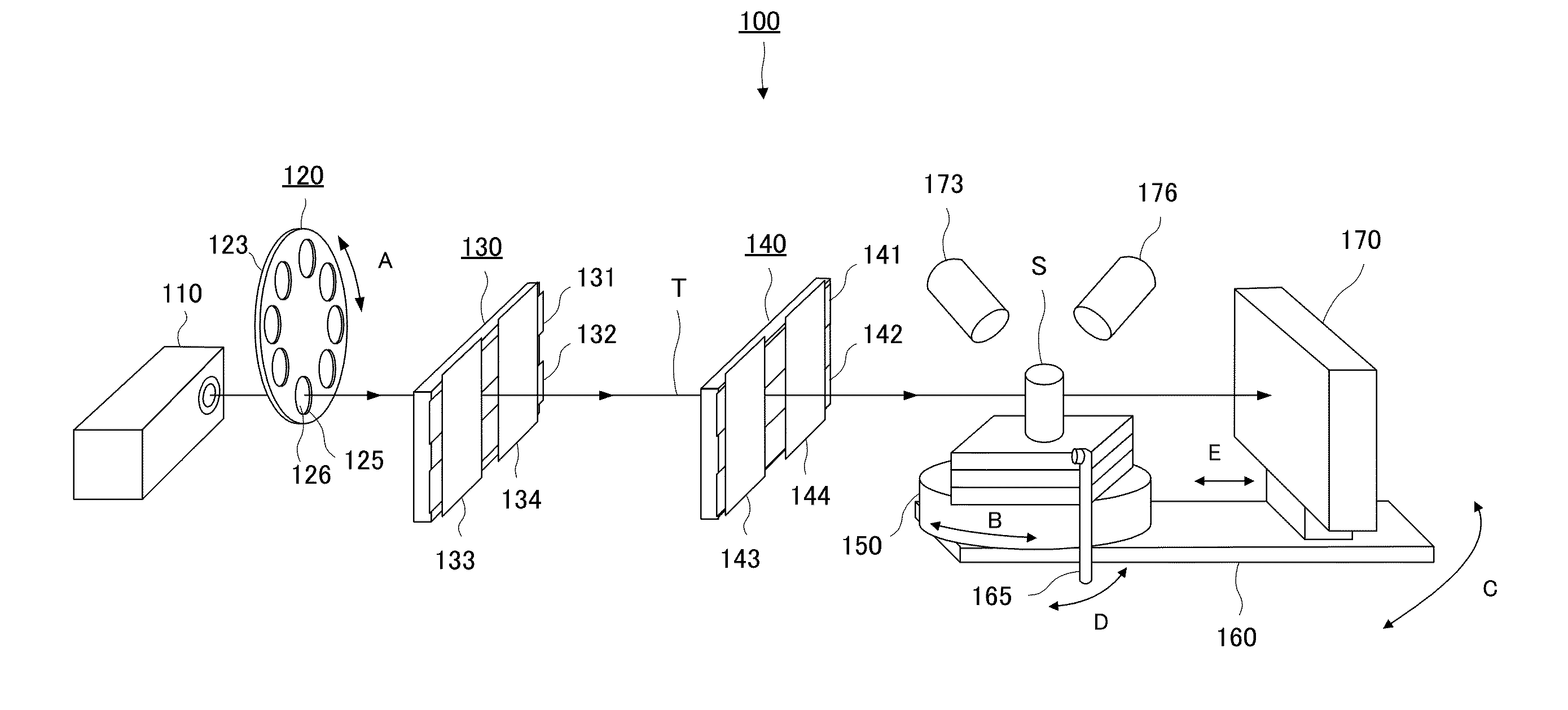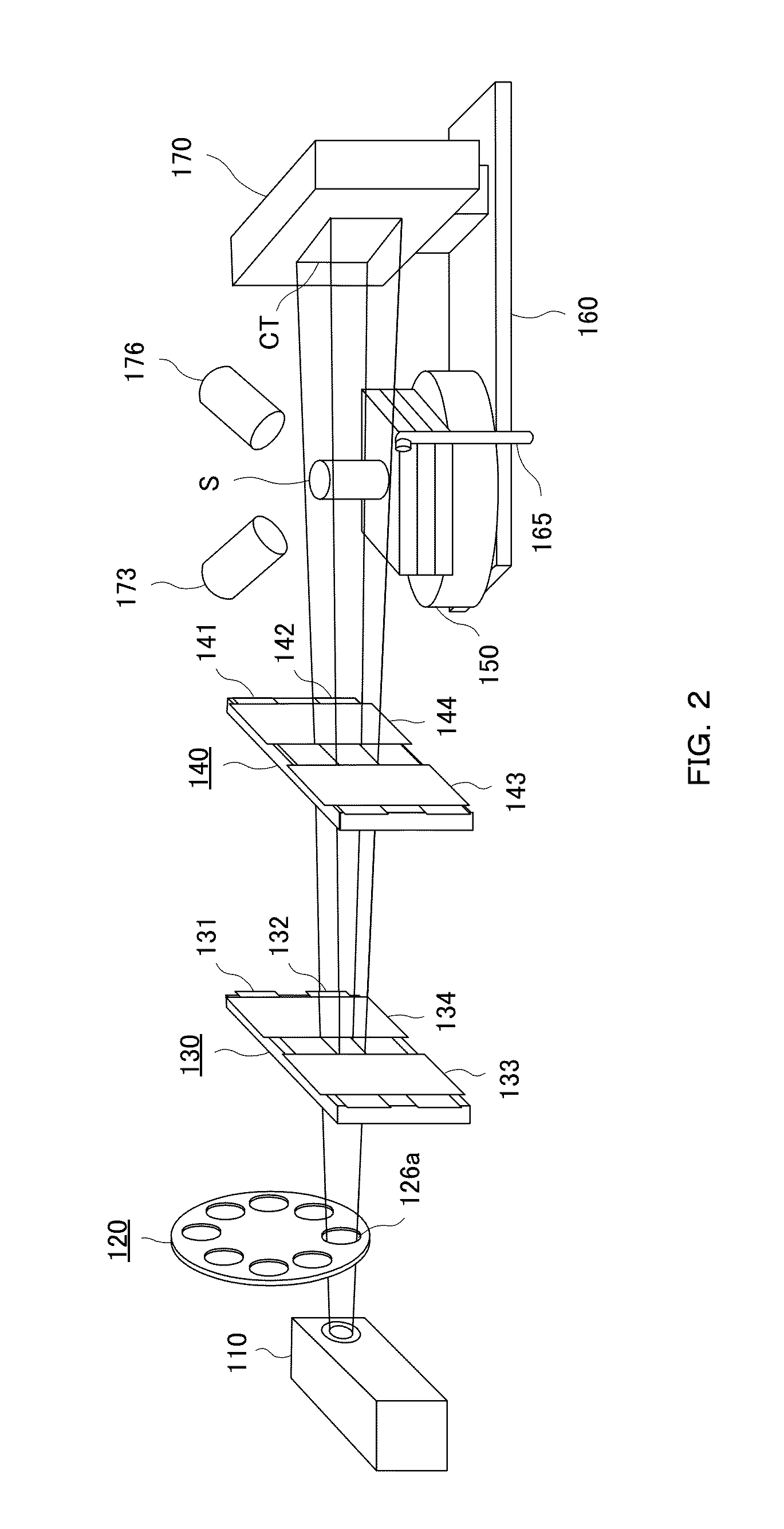X-ray composite apparatus
a composite apparatus and x-ray technology, applied in the direction of material analysis using wave/particle radiation, instruments, nuclear engineering, etc., can solve the problem that the apparatus cannot perform element analysis by fluorescent x-rays, and achieve the effect of saving space and saving user's effor
- Summary
- Abstract
- Description
- Claims
- Application Information
AI Technical Summary
Benefits of technology
Problems solved by technology
Method used
Image
Examples
first embodiment
[0040]FIG. 1 is a perspective view illustrating an example of a configuration of an X-ray composite apparatus 100. As illustrated in FIG. 1, the X-ray composite apparatus 100 is composed of X-ray source 110, a revolver-type filter switching part 120, electric slits 130 and 140, a sample support 150, a 2θ mechanism 160, a beam stopper 165, a two-dimensional detector 170, a camera 173, and a fluorescent X-ray detector 176. In FIG. 1, an irradiation direction of an irradiation path T of X-rays is indicated by an arrow.
[0041]The X-ray source 110 generates X-rays by means of application of a predetermined tube voltage. As a target, molybdenum, tungsten, silver, copper or the like is used, for example. The voltage to be applied can be adjusted by user's operation. An applied voltage of approximately 150 kV is suitable in the case of performing X-ray CT and an applied voltage of approximately 100 kV is suitable in the case of performing X-ray diffraction analysis.
[0042]The revolver-type fi...
second embodiment
[0058]In the above-described embodiment, the electric slits 130 and 140 are used as a collimator part which switches between the cone beam and the parallel X-rays, but a collimator 230 capable of advancing / retreating on the X-ray irradiation path may be also used. FIG. 5 is a perspective view illustrating an X-ray composite apparatus 200 using the collimator 230 instead of the electric slits 130 and 140. In FIG. 5, an irradiation direction of the irradiation path T of the X-rays is indicated by an arrow.
[0059]As illustrated in FIG. 5, the X-ray composite apparatus 200 includes the collimator 230 instead of the electric slits 130 and 140. The collimator 230 is capable of forming parallel X-rays on the irradiation path of the cone beam X-rays. The collimator 230 is capable of advancing / retreating in an F direction in FIG. 5 by, for example, the user's operation.
[0060]As described above, by advancing / retreating the collimator 230, an effort of adjustment or the like of opening / closing ...
application example
Procedures of Application Example
[0061]An application example using the X-ray composite apparatus 100 will be described. By using the X-ray composite apparatus 100 illustrated in FIG. 1 as below, component information, for the sample, identified from an X-ray diffraction measurement result or a fluorescent X-ray analysis result can be mapped on a CT image.
[0062]First, the upper and lower slits 131, 132, 141, and 142 and the left and right slits 133, 134, 143, and 144 are opened, and an interval between each slit is adjusted so that the sample S can be irradiated with the cone beam X-rays. Then, the entire sample S is subjected to cone beam X-ray CT. By using the cone beam, three-dimensional information of the entire sample can be grasped.
[0063]After the X-ray CT is finished, CT software is executed on a PC, X-ray CT data is used on the CT software to observe an X-ray CT image, and a location requiring component analysis is specified on the CT software. For example, a region of inter...
PUM
| Property | Measurement | Unit |
|---|---|---|
| applied voltage | aaaaa | aaaaa |
| applied voltage | aaaaa | aaaaa |
| thickness | aaaaa | aaaaa |
Abstract
Description
Claims
Application Information
 Login to View More
Login to View More - R&D
- Intellectual Property
- Life Sciences
- Materials
- Tech Scout
- Unparalleled Data Quality
- Higher Quality Content
- 60% Fewer Hallucinations
Browse by: Latest US Patents, China's latest patents, Technical Efficacy Thesaurus, Application Domain, Technology Topic, Popular Technical Reports.
© 2025 PatSnap. All rights reserved.Legal|Privacy policy|Modern Slavery Act Transparency Statement|Sitemap|About US| Contact US: help@patsnap.com



